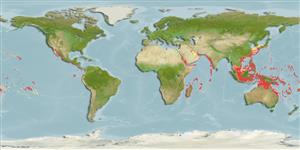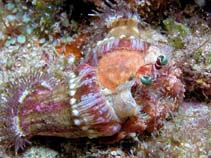Dardanus pedunculatus (Herbst, 1804)
Anemone hermit crab| Native range | All suitable habitat | Point map | Year 2050 |

|
| This map was computer-generated and has not yet been reviewed. |
| Dardanus pedunculatus AquaMaps Data sources: GBIF OBIS |
Classification / Names Common names | Synonyms | CoL | ITIS | WoRMS
Malacostraca | Decapoda | Diogenidae
Environment: milieu / climate zone / depth range / distribution range Ecology
Benthic; depth range 1 - 95 m (Ref. 96667). Tropical
Distribution Countries | FAO areas | Ecosystems | Occurrences | Introductions
Indo-Pacific: Seychelles to Japan and Hawaii.
Length at first maturity / Size / Weight / Age
Maturity: Lm ? range ? - ? cm
Life cycle and mating behavior Maturity | Reproduction | Spawning | Eggs | Fecundity | Larvae
Main reference
References | Coordinator | Collaborators
Davie, P.J.F. 2002 Crustacea: Malacostraca: Eucarida (Part 2): Decapoda - Anomura, Brachyura. In A. Wells and W.W.K. Houston (eds.) Zoological Catalogue of Australia. Vol. 19.3B. Melbourne: CSIRO Publishing, Australia xiv 641 p. (Ref. 8423)
IUCN Red List Status
(Ref. 130435: Version 2025-1)
CITES status (Ref. 108899)
CMS (Ref. 116361)
Threat to humans
Human uses
| FishSource |
Tools
More information
Max. ages / sizes
Length-weight rel.
Length-length rel.
Length-frequencies
Mass conversion
Abundance
Internet sources
BHL | BOLD Systems | CISTI | DiscoverLife | FAO(Publication : search) | Fishipedia | GenBank (genome, nucleotide) | GloBI | Gomexsi | Google Books | Google Scholar | Google | PubMed | Tree of Life | Wikipedia (Go, Search) | Zoological Record



